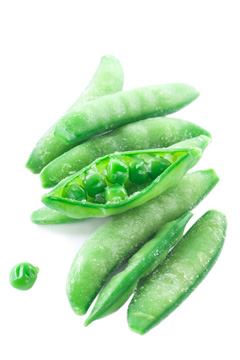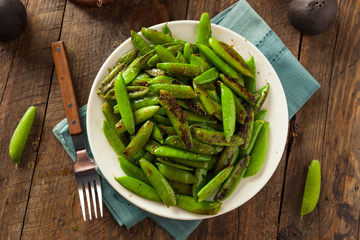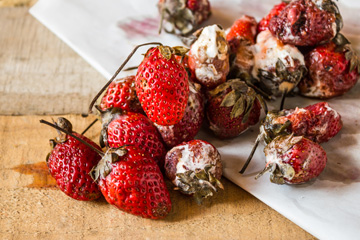
Preserving Edible Pea Pods

Preserving spring peas has long been popular, but have you given thought to preserving edible pea pods?
Sugar snap peas are a cross between garden peas and edible pod peas. You can recognize them by their nonfibrous, plump, edible pod and fat, juicy peas. While the snow pea or Chinese edible pod was in the past found only in the finest Asian cookery, it is now used in a variety of tasty dishes. Gardeners can select from several varieties, recognizable by their broad, flat pods. The kidney-shaped peas inside the pod are much smaller than sugar snap peas.
You can use raw edible pea pods in many ways — in salads (raw or blanched), stir-fried dishes, casseroles or an otherwise ordinary bowl of soup. Just heat and eat, or cook until soft, as you would green beans.
Freezing is the best way to preserve edible pea pods, as it provides the best quality product for later use. Take the extra time to blanch the pods, since unblanched vegetables will have an undesirable flavor and texture and lose vitamins during storage. Blanching stops enzymes from continuing the ripening process.
Follow these steps to blanch and preserve your pea pods:
- Wash and trim ends of pods, removing any strings.
- Place 2 cups of peas in a wire basket or cheesecloth bag and immerse in 1 gallon of boiling water. Cover and begin counting time immediately.
- Boil 1 minute for thin snow peas, or 1½–2 minutes for thick sugar snap (until heated through).
- Cool for 2 minutes in cold running water.
- Drain and pack in moisture- and vapor-proof, sealed containers. Or freeze quickly on cookie sheets before packaging (great for stir-fry).
Note: Canning or drying edible pea pods is not recommended because both preservation methods will generate undesirable changes in texture.
Sautéed Sugar Snap Peas

Ingredients:
- 1½ pounds fresh or frozen sugar snap peas
- 1 tablespoon good olive oil
- 1½ teaspoons salt
- ¾ teaspoon freshly ground black pepper
Instructions:
- Remove and discard the stem end and string from each sugar snap pod.
- Heat the olive oil in a large sauté pan over medium-high heat.
- Add the sugar snap peas, salt and pepper and sauté, tossing occasionally for 3 to 5 minutes, until the sugar snap peas are crisp tender.
- Place the sugar snap peas in a bowl for serving.
Source: Kelly, Tammy. 2016. “What’s New … Sugar Snap Peas.” North Carolina Cooperative Extension, May 3, 2016 https://lenoir.ces.ncsu.edu/2016/05/whats-newsugar-snap-peas/ (no longer available online).
Food Too Good to Waste

The numbers are staggering. As much as 40% of the food in the U.S. goes to waste, even while so many people are food insecure. An average family of four wastes $1,365–$2,275 in food each year. This waste leads to losses in community health, economic growth and environmental prosperity.
So how can preserving food at home help? In many ways! Let’s look at food preservation with preventing food waste in mind.
- If you have more tomatoes, peppers or other produce than you can use, you can preserve it for later use instead of throwing away the food and wasting it. When you preserve the food, be sure to use up-to-date food preservation recipes and methods to ensure best safety and quality. Older recipes may have outdated information that is no longer considered safe. If your preserved food could make people sick, it should be thrown away rather than eaten — so be sure to safely preserve it so it will not go to waste.
- When you preserve your food, always label it by name and the date it was preserved to make timely use of the food easier. You should use home-canned foods within one year. Frozen foods should be used within six months to a year, depending on the food and type of packaging. It’s important to use the food that you preserved while it is still safe and of high quality. Any food not used within its safety window should be discarded, which would contribute to rather than reduce food waste.
- Leftovers not eaten within one to two days can be frozen for a later meal, instead of tossed in the trash.
- Plan ahead and freeze meals for busy days. For added convenience, divide meals into single-serve portions before freezing. You’re not only preparing easy lunches or a quick evening meal for yourself, but also helping to reduce food waste by planning a later use for leftovers from a large batch of food that might otherwise be discarded.
- Pay attention to grocery store ads to get foods on sale. Prepare such foods as chicken, and divide and freeze them for later use. That’s one less ingredient to prepare on busy days! Again, you’re reducing waste by planning to preserve food for later use, rather than throwing away unused leftovers.
- Whether you preserve your own food or not, shop your cabinets, refrigerator and freezer first. Then create your shopping list so you don’t buy foods you already have. Using what you already have first helps saves you money, because you’re not buying excess food that may need to be discarded because you don’t eat it while it is still safe to consume.
These and many other ways to reduce food waste can be found at https://www.ksre.k-state.edu/foodsafety/topics/food-waste.html. Are you up to the challenge?